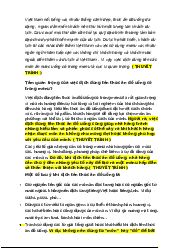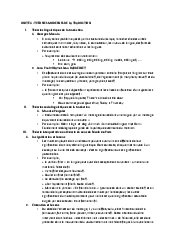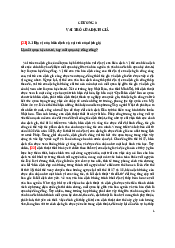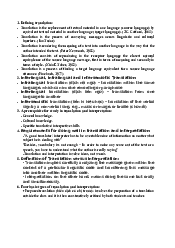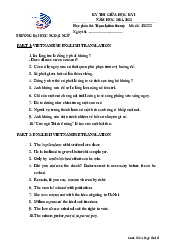


Preview text:
5 definitions of translation: -
Catford: Translation is the replacement of textual material in one language (source language) by equivalent textual material in
another language (target language). – Là sự thay thế ngữ liệu trong 1 ngữ này (ngôn ngữ nguồn) bằng những ngữ liệu tương
đương trong 1 ngôn ngữ khác (ngôn ngữ đích)
Ex: If we translate an English song to a Vietnamese version.
English - source language, Vietnamese – target language. -
Ian Tudor: Translation is the process of conveying messages across linguistic and cultural barriers. (là quá trình truyền tải thông
điệp vượt qua những rào cản về ngôn ngữ và văn hóa). Message is an underlying meaning. (thông điệp mang ý nghĩa hàm ẩn)
Ex: What time is it? -> form (gram & vocab): Mấy h rồi hả con?
But when you play video games at 10p.m -> message (underlying meaning): Có biết mấy h rồi không hả Explicit (: It’s 10p.m
Implicit: It’s too late. Unless you go to bed now, you will regret. -
Newmark: Translation is rendering the meaning of a text into another language in the way that the author intended the text.
(chuyển tải ý nghĩa qua ngôn ngữ khác theo văn phong (ý) của tác giả) -
Nida & Taber: Translation consists of reproducing in the receptor language the closet natural equivalence of the source language
message, first in terms of meaning and secondly in terms of style. (bao gồm tái hiện lại trong ngôn ngữ nhận (ngôn ngữ đích) sự
tương đương tự nhiên nhất của thông diệp truyền tải trong nn nguồn, về mặt ý nghĩa và văn phong)
Receptor language = target language/ Style: ex: formal/ informal letter. -
Pinchuck: Translation is a process of finding a target language equivalent to a source language utterance.
Equivalence is the similarity between a word( or expression) in a language and its translation in another. 4 types of equivalence: -
Linguistic equivalence: where there is homogeneity (sự đồng nhất) on the linguistic level (cấp độ ngôn ngữ) of both SL and TL
text, i.e. word for word translation. => lexical equivalence.
Ex: love is blind: ty mù quáng/ time is money: tgian là tiền bạc -
Paradigmatic equivalence (equivalence of elements of grammar): where there is equivalence of “the elements of a paradigmatic
expressive axis” (các yếu tố của trục biểu đạt nghịch lý), i.e. elements of grammar, which Popovic sees as being a higher
category than lexical equivalence.
Ex: dont pour oil into fire: đừng thêm dầu vào lửa/ study, study and study: học, học nữa, học mãi/ love me, love my dog: yêu
nhau yêu cả đường đi lối về. -
Stylistic (translational) equivalence (Sự tương đương về mặt phong cách (dịch thuật)), where there is “functional equivalence
(sự tương đương về chức năng) of elements in both original and translation aiming at an expressive identity with an invariant of
identical meaning.” (tương đương các biểu đạt ý nghĩa với biểu hiện).
Ex: spare the rod, spoil the child: thương cho roi cho vọt, ghét cho ngọt cho bùi/ a public hall is never swept: cha chung không ai khóc. -
Textual (syntagmatic) equivalence, where there is equivalence of form and shape. (Tương đương về mặt văn bản (cú pháp), ở đó
có sự tương đương về hình thức, hình dạng.) ex: the more the marrier: càng đông càng vui/ fair face poor fate: hồng nhan bạc
phận/ silence is golden: im lặng là vàng/ nothing stings like truth: sự thật mất lòng. 2 types of untranslatability: -
Linguistic untranslatability: occurs when there is no lexical or syntactical substitute (khi không có sự thay thế từ vựng hoặc cú
pháp) in the TL for an SL item. It is due to differences in the SL and the TL. -
Cultural untranslatability: is due to the absence in the TL culture of a relevant situational feature (không có đặc điểm tình huống
phù hợp) for the SL text. Ex: “Văn hóa Cồng Chiêng”- “the culture of Cong Chieng”/ “dân ca Quan họ” _ “Quan ho folk”. Translation methods: - Form-based and meaning-based:
A form-based translation is usually referred to as a literal translation, in which translators are attempting to follow the form of the source language.
The meaning-based translation is the one which is known as the idiomatic translation – the meaning of the source text is
expressed in the natural form of the target language. -
Word-for-word translation: This is often demonstrated as interlinear translation, with the TL immediately below the SL words.
The SL word order is preserved, and the words are commonly translated singly out of context.
This is often used as a pre-translation process to understand the mechanics of the SL text. (a pre-translation mechanism to gain sense of a dificult text)
Ex: “Không có gì quý hơn độc lập và tự do.” -> “Nothing is more precious than independence and freedom.” -
Literal translation: (dịch sát nghĩa, không xem nghĩa tổng thể) The SL grammatical constructions are converted to their nearest
TL equivalents (Cấu trúc np được bhien bằng ctruc np tương đương), but the lexical words are still translated singly out of
context. As a pre-translation process (các từ vựng được dịch đơn lẻ ra khỏi ngữ cảnh), this indicates the problems to be solved.
Ex: “Give me a hand” -> “Đưa cho tôi một tay”. -
Faithful translation: (từ được chuyển tải theo ngữ cảnh gần nhất) a faithful translation attempts to reproduce the precise (exact)
contextual meaning of the original within constraints of the TL grammatical structures. It ‘transfers’ cultural words and
preserves the degree of grammatical and lexical abnormality (deviation from SL norms) in the translation. Translation of this
type attempts to be completely faithful to the intention of the SL writer. Ex: A barking dog never bites. -> Chó sủa là chó khồng cắn -
Semantic translation: this is the difference from Faithful translation as it takes more account of the aesthetic value (that is, the
beautiful and natural sound) of the SL text, compromising on meaning (chấp nhận thỏa hiệp về nghĩa – loss and gain) where
appropriate so that no assonance, wordplay or repetition jars in the finished version.
It is different from Faithful translation as the former is more flexible while the latter is uncompromising and dogmatic.
Ex: ‘Give me a hand’ -> “Hãy giúp mình một tay”/ ‘Who manages the pagoda?’ -> ‘Ai là trụ trì của ngôi chùa này?’ -
Adaption: (phỏng dịch – dùng cho thơ ca, văn chương) This is the “freest” form of translation (Đây là hình thức dịch thuật “tự
do nhất”) It is used mainly for plays (comedies) and poetry: the themes, characters, and plots are usually preserved, the SL
culture converted to the TL culture and the text rewritten by an established dramatist or poet. -
Free translation: Free translation reproduces the matter without the manner or the content without the form of the original.
Usually, it is a paraphrase much longer than the original, a so-called “intralingual translation”, not a real translation at all. Ex:
“Không có gì quý hơn độc lập và tự do.” -> “Free or dead” -
Idiomatic translation: Idiomatic translation reproduces the ‘message’ of the original but tends to distort nuances of meaning
(bóp méo các sắc thái ý nghĩa) by preferring colloquialisms and idiom where these do not exist in the original. Ex: “It rains cats
and dogs” -> “Mưa tầm tã”/ “Love me, love my dog” -> “Yêu nhau yêu cả đường đi lồi về” -
Communicative translation: Communicative translation attempts to render the exact contextual meaning of the original in such
a way that both content and language are readily acceptable and comprehensible to the readership. (dịch chính xác ý nghĩa và
ngữ cảnh của vb gốc). Ex: “Life is not a bed of roses.” -> “cuộc đời thật lắm chông gai (csong ko dễ dàng gì).
Translation and interpretation: -
4 basic types of trans and inter:
+ Prepared translation: (biên dịch có chuẩn bị) involves the preparation of a translation outside class and it is then constructively
criticized by both students and teachers. (have much time to get well-prepared before writing a translation). Ex: You have a
project of translating a children’s book within 3 months for a foreign
publisher, you have a lot of time to translate carefully.
+ Sight translation: (dịch dựa trên vb viết)_includes an immediate, oral rendition based on a written text with focus on speech of
response. (do not have time to read the complete text before you start, learn to read ahead while translating, then do an oral
rendition based on a written text). => The major difference between sight translation and prepared translation is speed of response.
Ex: When your grandpa asks you about the instruction for use of a foreign produce, you will have a quick look, then translating when reading
+ Consecutive interpretation: (dịch đuổi/ dịch ấn đoạn) _ is the process of listening to a speech or lecture in one language and at
a certain moment, transcribing and summarizing it orally, in another language. The time lapse between the speech and your
interpretation varies.( good memory+ summarize the content, then interpret after the speaker stops talking, the time lapse varies)
Ex: When you are a tutor/ an assistance for a foreign teacher in a foreign center, you translate then oral feedback of the teacher
for leaners after he/ she finish his/ her speed.
+ Simultaneous interpretation: (dịch //, dịch đồng thời, dịch cabin) _ involves the immediate, simultaneous interpretation of
what is being said into another language.( no time at all, immediately you have to simultaneously render what is being said into
another language. – calls upon the ability to paraphrase).
In summary, translation and interpretation are complex skills. As well as specialized skills, both of them upon vast areas of
general knowledge and the ability to switch language codes. -
Difference between trans and inter:
+ The field of translation and interpretation is especially demanding because of the variety of complex tasks that are involved in
terms of: General knowledge/ Cultural knowledge/ Specific translative or interpretive skills.
=> All these tasks are in addition to Proficiency (sự trôi chảy/ mức độ thành thạo) in the language to be used, which is clearly a
prerequisite (điều kiên tiên quyết) for study in translation and interpretation.
+ "A good translator/interpreter has to be a veritable mine of information no matter what subject he is dealing with. If you are
interpreting a lecture on genetics and you don't know what a chromosome is, you are in deep trouble! Or, if you have to
translate a paper on the effects of increased taxation on aggregate demand, you are up the proverbial creek without a paddle if
you have never had a course in economics. Besides, vocabulary is not enough - in order to make any sense out of a text or a
speech, you have to understand what the author is really saying. “Translation and interpretation involve ideas, not words (an
enormous amount of knowledge in variety of areas)
Name the 3 laws of translation formulated by tytler(1978): -
The translation should give a complete transcript of the idea of the original work (bản dịch nên cung cấp 1 phiên bản hoàn chỉnh
biểu đạt ý nghĩa của tác phẩm) -
The style and manner of writing should be of the same character with that of the original (văn phong và lối diễn đạt của bản gốc
như thế nào thì bản dịch như thế đó) -
The translation should have all the ease of the original composition (bản dịch phải có lối diễn đạt mượt mà giống như vb gốc) Một số khái niệm: -
Source language means the language of the original language. -
Target language means the language of translated text -
The purpose of translation is to transfer the semantic translation of the SL text into the TL. -
The purpose of translation is to transfer the meaning of the SL. into the TL. -
Newmark's definition of translation focuses on rendering the meaning of a text. -
The process of translation, as claimed by lan Tudor, involved dealing with 2 barriers concerning linguistic and cultural in the process of translation. -
Sight translation differs from prepared translation in the speed of response. -
Semantic translation is entirely based on the SL. -
Carbin translation is often used to stand for simultaneous translation -
Semantic translation includes a literal and faithful translation. -
Communicative translation produces a more effective way of translation. -
Language is the heart within the body of culture. -
An overlapping method of translation is the combination between semantic and communicative translation. -
The Vietnamese concept "bài chòi "cannot be translated into English as it is a case of cultural knowledge. -
The rendering of" nhã nhạc cung dinh" into" royal music" in English an example of loss in meaning. -
The rendering of " a man without a weapon" into "người không một tấc sắt trong tay" is an example of gain translation. -
The simile" as soft as butter" can be rendered into Vietnamese as "mềm như bún " by replacing the image. -
Of the three words "slim, slender, skinny", the word " slender" has a more positive connotation. -
By retaining the image, the metaphoric expression of " ray of hope" can be rendered into Vietnamese as tia hi vọng. -
The communicative translation of "Nuôi con bằng sữa bình hay bằng sữa met " can be "Bottle or breast -
" Half a loaf is better than no bread "can be idiomatically rendered into Vietnamese as "có còn hơn không" -
An idiomatic translation of “nghệ thuật ẩm thực ấn độ " can be " A taste of India" -
"a man is known by the company he keeps can be idiomatically rendered into VNese as "xem bạn biết người" -
An idiomatic translation "xin đừng nhớ chuyện đã qua" can be "let “Bygones be bygone" -
Newmark defines translation as rendering the meaning of a text into another language. -
The process translation, according to lan Tudor, involves dealing with matters involving linguistic and cultural barrier. -
Translation means receptor language. -
What makes prepared translation differ from sight translation is the speed of response. -
Communicative translation involves a more of meaning. -
As gentle as a lamb: hiền như bụt -
Idiomatic translation "don't tell a book by its cover": dùng trông mặt mà bắt hình dong. -
What is the stylistic equivalence of "safety is first" an toàn là trên hết -
Give a free translation of "i don't know what love is": tình yêu là gì -
Semantic translation "Road users" làn đường dành cho người đi bộ -
The rendering of "a public hall is never swept" into "cha chung không ai khóc" is an example -
ở hiền gặp lành: stay gently, meet evenly -
con rồng cháu tiên: children of the fairy and the dragon -
có công mài sắt có ngày nên kim: no pain no gain -
chậm mà chắc: more haste less speed -
đỏ bạc đen tình: lucky at cards, unlucky in love -
không có lửa làm sao có khói: there is no smoke without fire. -
Tình yêu mù quáng: love is blind -
xa mặt cách lòng: Out of side out of mind
